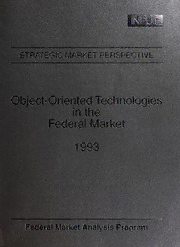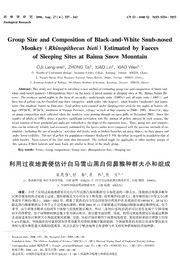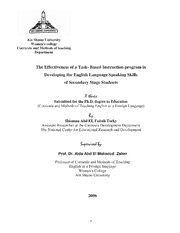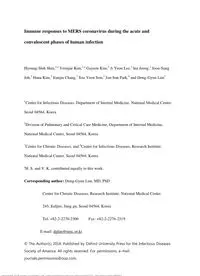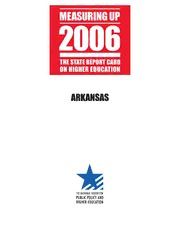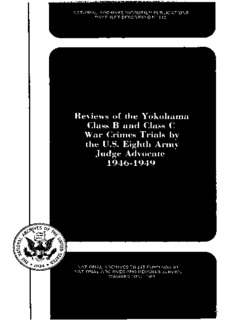
national archives microfilm publications pamphlet describing m1112 national archives trust fund ... PDF
Preview national archives microfilm publications pamphlet describing m1112 national archives trust fund ...
NATIONAL ARCHIVES MICROFILM PUBLICATIONS PAMPHLET DESCRIBING M1112 NATIONAL ARCHIVES TRUST FUND BOARD NATIONAL ARCHIVES AND RECORDS SERVICE WASHINGTON: 1981 records reproduced in the microfilm publication are from Records of Allied Operational and Occupation Headquarters, World War II Record Group 331 REVIEWS OF THE YOKOHAMA CLASS B AND CLASS C WAR CRIMES TRIALS BY THE U.S. EIGHTH ARMY JUDGE ADVOCATE 1946-1949 On the 5 rolls of this microfilm publication are reproduced the reviews of 314 class B and class C war crimes cases by the Office of the Staff Judge Advocate, U.S. 8th Army. The reviews pertain to cases tried in Yokohama, Japan, by U.S. military commissions appointed by Headquarters, U.S. 8th Army, and involve such crimes as torture, ceremonial murder, acts of revenge, misuse of command responsibility, mistreatment of prisoners of war and civilian populations, and illegal medical experiments conducted on prisoners of war. The reviews are part of the records of the Legal Section of the Supreme Commander, Allied Powers, in Records of Allied Operational and Occupation Headquarters, World War II, Record Group (RG) 331. The records contain trial dates, personal data of the accused, synopses of charges, findings, pleas, and legal reviews. There are summaries of prosecution and defense evidence and the opinions and recom- mendations of the Staff Judge Advocate. Background Since early 1942, various world leaders, including Generalissimo Chiang Kai-shek of China and U.S. Vice President Henry A. Wallace, had called for the punishment of Japanese war criminals. The trial of Japanese war criminals was not a certainty, however, until the Potsdam Proclamation of the leaders of the Allied Powers in 1945, which stated: "We do not intend that the Japanese should be enslaved as a race or destroyed as a nation, but stern justice shall be meted out to all war criminals including those who have visited cruelties upon our prisoners." By signing the instrument of Japanese surrender, the Japanese Plenipotentiaries Mamoru Shigemitsu and Yoshijiro Umezu, who were later tried by the International Tribunal for the Far East (IMTFE), accepted for Japan the provisions of the Potsdam Proclamation. The U.S. Joint Chiefs of Staff charged Gen. Douglas MacArthur, the Supreme Commander, Allied Powers (SCAP), with the implementation of the war criminals program, which called for investigation, detention and trial of persons suspected of war crimes. Trial authorities grouped Japanese war crimes cases into three classes — class A, or major, cases, tried by the IMTFE, and class B and C cases, tried for the most part by military commissions appointed by the commanding general, U.S. 8th Army. Class A war crimes cases involved planning, initiation, and waging wars of aggression. Class B and C cases, on the other hand, mostly 'concerned violations of the laws of war, including atrocities committed against civilians, races, groups, and prisoners of war. Class A War Crimes Trials At the end of April 1946, General MacArthur proclaimed a charter for the IMTFE, which was later modified by members of the tribunal and prosecution staffs of various member countries and approved by the Far Eastern Commission, which supervised policy making for the Far East. The charter of the IMTFE called for a multinational tribunal to try cases involving conventional war crimes, crimes against humanity, and crimes against the peace. The charter ensured the accused of certain rights, including the right to be represented by counsel and to offer evidence in their own behalf. The charter suspended ordinary rules of evidence, making hearsay admissible as evidence provided it had probative value. From May 3, 1946, to November 12, 1948, the IMTFE tried the class A cases, involving 28 individuals, about half of which were army officers. Naval officers, cabinet ministers, other officials, and propagandists comprised the remainder of the defendants. The IMTFE sentenced 7 of the accused to death, 16 to life imprisonment, and 2 to prison terms of a number of years. The other three defendants died or became insane before sentencing. Class B and C War Crimes Trials Following authorization by SCAP on December 5, 1945, the commanding general, U.S. 8th Army, began to appoint military commissions to try class B and class C war crimes cases, mainly in Yokohama. The commissions at Yokohama tried 996 class B and class C defendants. They acquitted 142, and sentenced 124 to death, 63 to life imprisonment and the remainder to prison terms of varying length. A reviewer from the Office of the Judge Advocate General of the U.S. 8th Army examined each class B and C case to determine whether the tribunal had committed any legal errors to the dis- advantage of the accused. He developed a synopsis of the facts and an opinion and recommended approval or disapproval of the findings of the tribunals. Often, trials involving findings of not guilty did not go through the reviewing process. The U.S. 8th Army Judge Advocate then examined the review, together with the record of the trial, and either added his opinions and recommendations or concurred with the findings of the reviewer. Thereupon he passed the review to the commanding general for final action, which in most cases confirmed life sentences and prison terms. Death sentences passed through an additional review and required confirmation by SCAP. The Supreme Commander confirmed death sentences of 51 individuals and ordered them executed; he reduced most of the remaining death sentences to prison terms. In addition to the trials in Yokohama, other class B and class C trials took place in Shanghai and Manila. Also the U.S. Navy tried a number of war crimes cases on Pacific islands such as Kwajalein in the Marshall Islands. The reviews of all these trials have great value for research, because they contain short and easily manageable summaries of the often voluminous records of Japanese war crimes trials. Records Description The reviews of the class B and C cases are arranged by case, or docket number, from 1 through 371. Of these, only 319 reached the trial stage, and a few did not require review because the commission acquitted the defendants. Thus there are no reviews for the following case numbers: 38 101 116 209 275 324 62 103 125 213 280 332 64 105 141 215 284 333 79 108 148 217 285 341 87 109 161 245 293 343 89 110 170 246 302 345 93 111 192 247 303 350 95 112 196 257 309 355 96 113 201 261 322 359 98 114 207 269 323 360 367 There are also docket numbers 39A, 173A, and 194A. The reviews range from 2 to 154 pages in length, with the majority running less than 20 pages. The personal data on the accused includes name, occupation, age, and military career information. Synopses of charges often contain specification of charges, although pleas and findings are usually given in the brief form of "guilty" or "not guilty." Summaries of defense and prosecution evidence include not only exhibits but also oral court testimony. The reviewers' opinion normally deals with the fairness and the legality of the trial. It is followed in the arrangement of the records by the recom- mendation of the reviewing officer of the Judge Advocate Section regarding sentence and place of confinement. A differing opinion or a concurrence by the chief of the section completes the review. The name of the commanding general of the U.S. 8th Army appears at the end of some of the early reviews. At the beginning of roll 1 are filmed the following key documents from which the class B and class C trials at Yokohama derived their jurisdiction: the Potsdam Proclamation of July 26, 1945; the charter of the International Military Tribunal for the Far East; the Far Eastern Commission Policy Decision of April 3, 1946; Regulations Governing the Trial of Accused War Criminals of December 5, 1945, by SCAP; and Rules of Procedure and Outline of Procedure for Trial of Accused War Criminals of February 5, 1946, by the commanding general, U.S. 8th Army. Two lists of names of individuals tried at Yokohama serve as finding aids; these lists follow this introduction as Appendixes A and B. The first list is arranged alphabetically by last name of accused, with the docket number of the case preceding the name; the other is arranged numerically by docket number. Related Records The reviews are closely related to Records of the Office of the Judge Advocate General (Army), RG 153, and in Records of the United States Army Commands, 1942- , RG 338, that appear in the following microfilm publications: United States of America v. Alfons Klein et al. (Case Files 12-449 and 000-12-31), October 8, 1945-October 15, 1945, M1078; United States of America v. Kurt Andrae et al. (and Related Cases), April 27, 1945-June 11, 1958, M1079; United States of America v. Franz Auer et al., November 1943-July 1958, Ml093; United States of America v. Ernst Dura et al., June 9-23, 1947, M1100; United States of America v. Otto Skorzeny et al., July 13, 1945-December 13, 1948, Ml 106; United States of America v. Kurt Goebell et al., February 6-March 21, 1946, and United States v. August Haesiker, June 26, 1947, Ml 103; German Documents Among the War Crimes Records of the Judge Advocate Division, Headquarters, United States Army, Europe, T1021. The reviews are also closely related to microfilmed records in National Archives Collection of World War II War Crimes Records, RG 238, specifically: Prosecution Exhibits Submitted to the International Military Tribunal, T988; Records of the Office of the United States Chief of Counsel for War Crimes, Nurenberg Military Tribunals, Relating to Nazi Industrialists, T301; Records of the United States Nurenberg War Crimes Trials: NOKW Series, 1933-1947, Til 19; NG Series, 1933-1948, Til39; HM Series, 1874-1946, M936; NP Series, 1934-1946, M942; WA Series, 1940-1945, M946; Guertner Diaries, October 5, 1934-December 24, 1958, M978; Records of the United States Nuernberg War Crimes Trials, United States of America v.: Karl Brandt et al. (Case I), November 21, 1946-August 20, 1947, M887; Erhard Milch (Case II), November 13, 1946-April 17, 1947, M888; Josef Altstoetter et al. (Case III), February 17, 1947- December 4, 1947, M889; Oswald Pohl et al. (Case IV), January 13, 1947-August 11, 1948, M890; Friedrich Flick et al. (Case V), March 3, 1947-December 22, 1947, M891; Carl Krauch et al. (Case VI), August 14, 1947-July SO, 1948, M892; Wilhelm List et al. (Case VII), July 8, 1947-February 19, 1948, M893; Ulrich Greifelt et al. (Case VIII), October 10, 1947-March 10, 1948, M894; Otto Ohlendorf et al. (Case IX), September 15, 1947-April 10, 1948, M895; Alfried Krupp et al. (Case X), August 16, 1947-July SI, 1948, M896; Ernst von Weizsaecker et al. (Case XI), November 4, 1947- April IS, 1949, M897; Wilhelm von Leeb et al. (Case XII), November 28, 1947- October 28, 1948, M898; Records of the United States Nuernberg War -Crimes Trials Inter- rogations, 1946-1949, Ml 019. In addition, the record of the IMT at Nuernberg has been published in Trial of the Major War Criminals Before the Inter- national Military Tribunal (Nuernberg, 1947), 42 vols. Excerpts from subsequent proceedings have been published as Trials of War Criminals Before the Nuernberg Military Tribunal Under Control Council Law No. 10, (U.S. Government Printing Office, 1950-53), 15 vols. Detailed finding aids with computer-assisted indexes for the microfilmed records of the Ohlendorf Case (Special List 42) and the Milch Case (Special List 38) have also been published. The National Archives and Records Service holds motion pictures and photographs of many sessions of the IMT and of the 12 U.S. Nuernberg proceedings as well as sound recordings of the IMT proceedings. The National Archives and Records Service holds motion pictures and photographs of many sessions of the IMTFE and of the class B and class C trials, and sound recordings of the IMTFE proceedings. A Preliminary Inventory of the Records of the International Military Tribunal for the Far East, Preliminary Inventory 180, describes the records of the IMTFE. John Mendelsohn prepared these records for microfilming and wrote these introductory remarks. APPENDIX A Names of Accused Arranged Alphabetically Case Number Name 31 Abe, Tatsuo 334 Abe, Tsunee 80 Adachi, Fukusaburo 289 Adachi, Seiichi 288 Aihara, Kajuro 290 Aihara, Kajuro 154 Aihara, Kazutane 320 Akaike, Kohei 17 Akamatsu, Shigeo 40 Akamatsu, Toranoshim 362 Akamine, Teruo 258 Akatsuka, Hanji 340 Akiba, Genzo 290 Akira, Hiroshi 288 Akita, Hiroshi 291 Akita, Niro 340 Akita, Teruo 177 Akiyama, Fukujiro 255 Akiyama, Yonesaku 223 Akutso, Toshi 339 Anaguchi, Shozo 328 Anjo, Hiroshi 157 Ano, Tetsuo 34 Aoki, Shoichiro 36 Aoki, Shoichiro 129 Aoki, Yuji 8 Aona, Shigeru 276 Aoyagi, Jimbei 263 Arai, Takahisa 256 Arakawa, Kazuo 45 Araki, Kuniichi 199 Aramaki, Sakujiro 346 Arao, Okikatsu 181 Ariizumi, Shigeru 243 Asada, Shigetsuchi 120 Asaka, Toshinori 182 Asakura, Todao 53 Asano, Yukio 43 Asari, Eiji 218 Asoma, Nakakichi 198 Azuma, Hiroshi 60 Baba, Kensako 107 Bando, Bunhachi Case Number Name 55 Beppu, Takeshi 13 Chigara, Naraichi 259 Chin, Mo Ei 307 Chiuma, Sazae 336 Chiuma, Sazae 339 Chuba, Tadayuki 200 Date, Tatsumi 337 Deguchi, Taichi 13 Eato, Shunsuke 314 EM, Yosoichiro 94 Egawa, Sachio 188 Eizumi, Shigeo 16 Emori, Hidetoshi 288 Enatsu, Tokuji 356 Enoki, Yoshinori 258 Enomoto, Muneo 126 Eto, Shigeki 329 Fujihira, Naotada 111 Fujii, Hiroshi 90 Fujii, Sannojo 200 Fujii, Shoichi 287 Fujiki, Fumio 339 Fuj imori, Yasuo 166 Fujimoto, Minoru 258 Fujinaka, Matsuo 310 Fujino, Ranjo 206 Fujino, Takeji 328 Fukioka, Hideo 276 Fujisaki, Seitaro 199 Fujisaki, Takenosuke 236 Fujita, Mitsuyoshi 91 Fujita, Shoshaburo 326 Fujita, Sietaro 289 Fujita, Takayashi 176 Fujita, Tatsuro 97 Fukarai, Kazio 198 Fukijima, Keitaro 327 Fukuda, Katsuma 74 Fukuda, Kingoro 262 Fukuda, Shigeru 94 Fukuda, Tokuro 6 Fukuhara, Isao 258 Fukumoto, Norio 338 Fukumura, Yuetsu 297 Fukunaga, Kiyozo 42 Fukunaga, Takeo 44 Fukunaga, Takeo 288 Fukushima, Kyusaku 290 Fukushima, Kyusaku
Description:The list of books you might like

The 5 Second Rule: Transform your Life, Work, and Confidence with Everyday Courage

The Sweetest Oblivion (Made Book 1)

The Strength In Our Scars

What Happened to You?
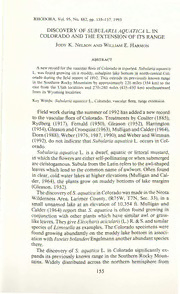
DISCOVERY OF SUBULARIA-AQUATICA L IN COLORADO AND THE EXTENSION OF ITS RANGE

Духовные христиане молокане в Амурской области во второй половине XIX - первой трети ХХ вв

Parásitos
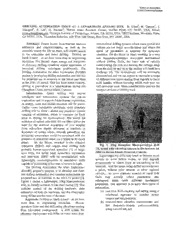
Drilling Automation Tests At A Lunar/Mars Analog Site
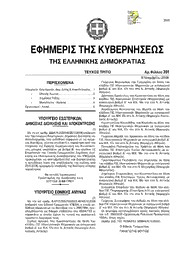
Greek Government Gazette: Part 3, 2006 no. 391
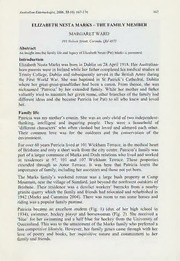
Elizabeth Nesta Marks - the family member

Avertissements Agricoles - Grandes cultures - Ile de France - 1993 - 8
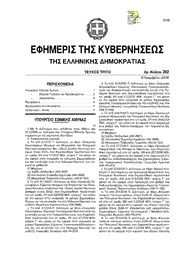
Greek Government Gazette: Part 3, 2006 no. 392
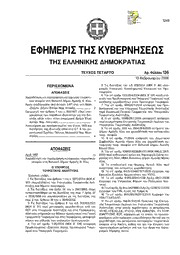
Greek Government Gazette: Part 4, 2006 no. 136
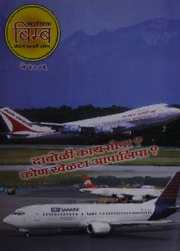
BIMB MASIK -MAY -2006
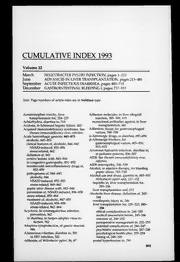
Gastroenterology Clinics of North America 1993: Vol 22 Index
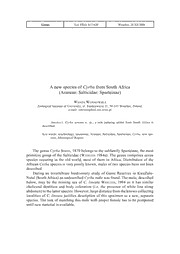
A new species of Cyrba from South Africa (Araneae: Salticidae: Sparteinae)

Listening in: Radio and the American imagination
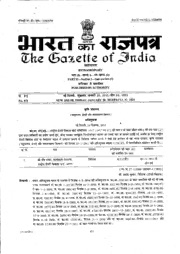
Extraordinary Gazette of India, 2012, No. 146
![[Walnut Grove Questers Yearbook 2005-06] book image](https://cdn.pdfdrive.to/media/content/thumbnails/6a985185-eaae-4e85-becd-e905f3e33a3b.webp)
[Walnut Grove Questers Yearbook 2005-06]
